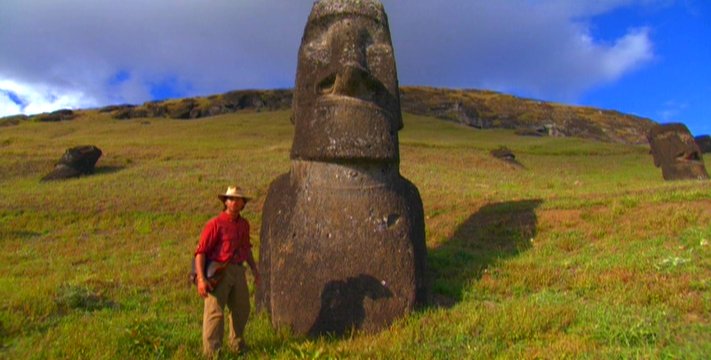
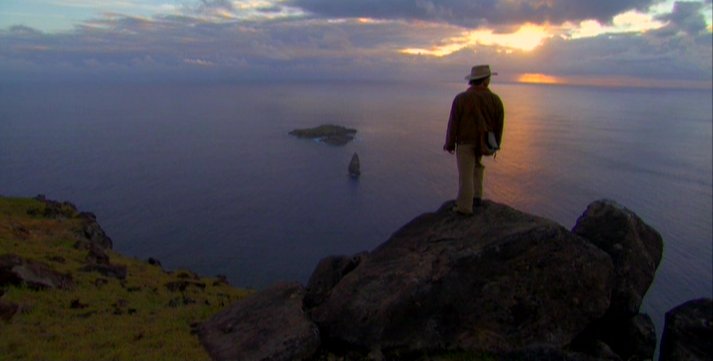
Ever since Easter Island was first discovered, this tiny pinprick of land in the middle of the Pacific Ocean has baffled scientists. How did the ancients who peopled this place even find it? Josh sets out to unveil the mysteries of the island and it's giant, haunting stone heads. Delving into the world of ancient Pacific Islanders, he relearns the lost art of Polynesian navigation, recreates the techniques of Easter Island masons, and participates in dangerous ancient rituals--all to solve one of the greatest enigmas of our time: the mystery of Easter Island.
Giants of Easter Island

Giants of Easter Island
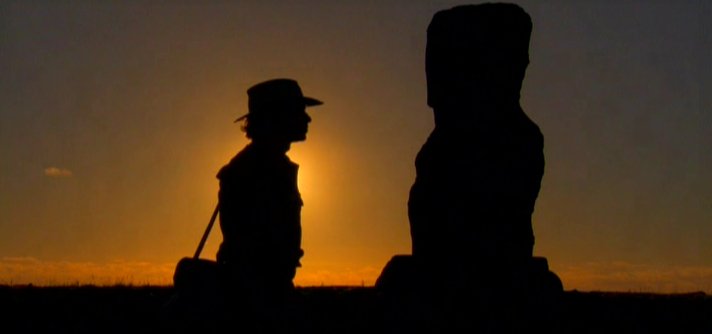 Easter Island: "Europeans first sailed to this island on Easter Sunday, 1722, and named it after the date of their landing. They discovered a society in ruin, an environment almost beyond repair. Adding to the mystery of its collapse were these huge stone sculptures called Moai which suggested a greatness of bygone days. What had happened to the people of this island? This is where my journey begins and, on an island with more horses than people, I decide to begin my exploration on horseback."
Easter Island: "Europeans first sailed to this island on Easter Sunday, 1722, and named it after the date of their landing. They discovered a society in ruin, an environment almost beyond repair. Adding to the mystery of its collapse were these huge stone sculptures called Moai which suggested a greatness of bygone days. What had happened to the people of this island? This is where my journey begins and, on an island with more horses than people, I decide to begin my exploration on horseback."
Polynesian Navigation: "One of the most impressive feats accomplished by the ancient Polynesians was the discovery of this tiny island. Flying to Easter Island from Santiago, Chile, I get a sense of just how amazing this is—for seven hours, we're flying over nothing but open sea. No islands, no indicators, no landmarks to help us on our way other than the modern GPS system the plane is using. The Polynesian sailors were intrepid explorers and remarkable navigators, able to read the slightest shift in the current and change in the wind. Local legends states that Hotu Matua was the leader of the group who first settled the island, bringing his extended family from Polynesia. He must have been a determined and self-sufficient man, willing to risk weeks at sea just to make a new life for themselves in the middle of the Pacific Ocean and well away from everyone else they knew."
modern GPS system the plane is using. The Polynesian sailors were intrepid explorers and remarkable navigators, able to read the slightest shift in the current and change in the wind. Local legends states that Hotu Matua was the leader of the group who first settled the island, bringing his extended family from Polynesia. He must have been a determined and self-sufficient man, willing to risk weeks at sea just to make a new life for themselves in the middle of the Pacific Ocean and well away from everyone else they knew."
The Moai: "Seeing the Moai for the first time is a magical thing. Comparing my feeling to seeing other stone structures and even the pyramids, the Moai evoke a much more comfortable and friendly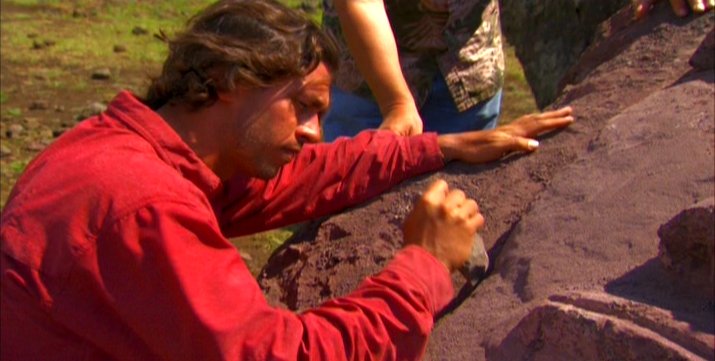 feeling. It's like they're guardians, watching over you. And with over 900 stone faces lying around, there's an assortment of personalities to read into the faces."
feeling. It's like they're guardians, watching over you. And with over 900 stone faces lying around, there's an assortment of personalities to read into the faces."
Making and Moving the Moai: "José shows me how to carve the soft volcanic tuff into a Moai, and it's fascinating. Within hours the face begins to appear, and I can see how an artist would take great pleasure and pride in creating a monument to honor the ancestors. But making the Moai, while time-consuming, isn't much of a mystery. MOVING them is. Sergio Rapu explains that the backs of the Moai were shaped like canoes, enabling them to slide down from the quarry to the flatland below. Once there, the bottoms of the Moai (what we'd consider the feet) were rounded a bit to enable the Moai to 'walk'—they'd wobble the statue from side to side much like we move cabinets or refrigerators today. Using long enough ropes and a trained team, a transport specialist would oversee the movement of these megalithic statues across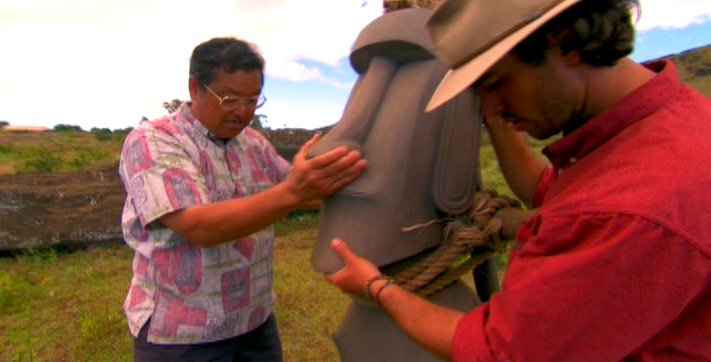 miles of established roads. Walking along these roads, it's very obvious to me that this was a major production—hundreds of Moai are either at the quarry awaiting completion, at the base of the quarry awaiting transport, or on the roads in the middle of their journey. And having tried to move a mini-Moai using both the horizontal (wooden beams) and vertical (walking) methods, I agree with Sergio that vertical is easier and more likely. It also explains the fallen Moai much more accurately, since they are almost all face-down in the earth with their feet toward the quarry."
miles of established roads. Walking along these roads, it's very obvious to me that this was a major production—hundreds of Moai are either at the quarry awaiting completion, at the base of the quarry awaiting transport, or on the roads in the middle of their journey. And having tried to move a mini-Moai using both the horizontal (wooden beams) and vertical (walking) methods, I agree with Sergio that vertical is easier and more likely. It also explains the fallen Moai much more accurately, since they are almost all face-down in the earth with their feet toward the quarry."
The Caves of Rapa Nui: "José Latelier Morel takes me through some of the caves of Rapa Nui. Caves are great natural shelters, especially in warmer climates where they stay cool even on hot days. But I expected the people of Rapa Nui to begin living in the caves, then eventually move out onto the landscape above. José explains it was just the opposite—they went from their villages above into the caves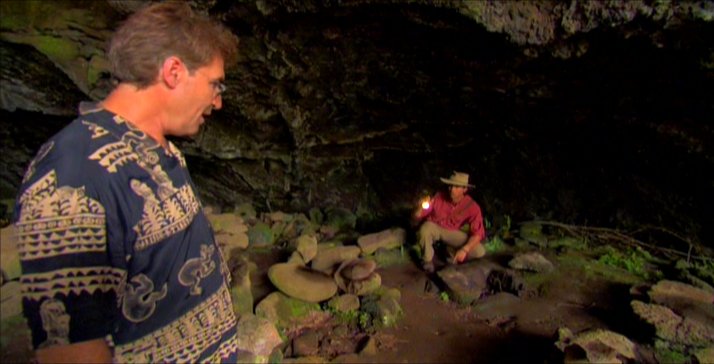 below, living a hand-to-mouth existence 1000 years after they first landed here. Some archeologists paint a picture of desperate survival, where wood and food are in short supply and the people are waging war against each other, living below ground for safety. Some even suggest cannibalism, which I can only imagine was a terrorizing reality of their desire to survive."
below, living a hand-to-mouth existence 1000 years after they first landed here. Some archeologists paint a picture of desperate survival, where wood and food are in short supply and the people are waging war against each other, living below ground for safety. Some even suggest cannibalism, which I can only imagine was a terrorizing reality of their desire to survive."
The Birdman Cult: "When I was a kid, there was a cartoon on TV called 'Birdman'—maybe it's still on now. But the superhero would shout 'I am Biiiiiiiiiiiiird-Maaaaaaaaan' on each show, and I find myself doing that several times while on the island. In reality, though, the Birdman cult was not a superhero thing but a way for the people to control their resources through a creative and competitive contest. Trying the contest myself, I can only say how challenging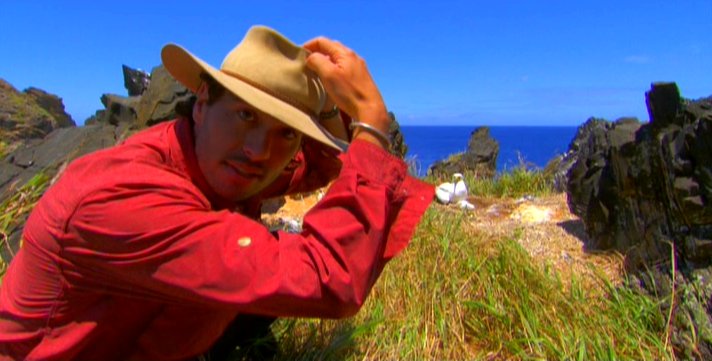 the swim part is (the rock climb is illegal and very deadly). The swells and current are significant, and there ARE sharks in the water—although some say they attack, others say they don't. My biggest problem is with the reed floater, which is way too round and bouyant for me to stay on top of. Perhaps my wetsuit is a mistake—but others later tell me that most reed floaters were flat, not round. Makes sense to me and, I'm guessing, to most surfers."
the swim part is (the rock climb is illegal and very deadly). The swells and current are significant, and there ARE sharks in the water—although some say they attack, others say they don't. My biggest problem is with the reed floater, which is way too round and bouyant for me to stay on top of. Perhaps my wetsuit is a mistake—but others later tell me that most reed floaters were flat, not round. Makes sense to me and, I'm guessing, to most surfers."
Rapa Nui Today: "The people of Easter Island have created a new livelihood for themselves through tourism and the iconic appeal of the Moai. But the environment is still fragile, and the people can live in only a few places where trees have been planted. A lot of the island is still desolate grassland where only the horses and ospreys live. I do think that the story of Easter Island holds an important message for us all. Our world is very much an island of limited resources and it needs to be managed more carefully if we're not to endure the same fate as the original inhabitants of Rapa Nui."
important message for us all. Our world is very much an island of limited resources and it needs to be managed more carefully if we're not to endure the same fate as the original inhabitants of Rapa Nui."